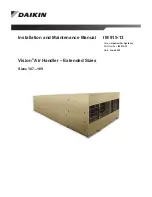
IM 915-13 • VISION - EXTENDED SIZES 4
www.DaikinApplied.com
General Information
Unit Storage
• Skyline units may be stored outdoors. Follow the below
instructions to ensure proper storage. Any damage to the
unit resulting from improper storage will not be covered
by Daikin Applied.
• Ensure no moisture, debris, or minerals are on the unit
prior to storage, as these can cause cause permanent
damage to the cabinet and components.
• Store units in a clean, dry environment on a level surface.
Ensure units are on a dry surface or raised off the ground
to protect components from any standing water; ensure
adequate support is used to prevent the unit or section
base from sagging, if raised.
• All openings, including dampers and bottom openings,
must be covered to protect from rain, snow, dust, and
animals. Do not use plastic tarps to cover the unit, as
condensation can form on the air handler resulting in
corrosion or stains. Use only canvas tarps to ensure the
inside of the unit remains clean, dry, and ventilated. Do
not allow coverings to trap moisture on surfaces.
• All tarps should be inspected frequently to ensure the
integrity of the tarp is maintained and to prevent damage
to the unit by the elements. Any damage to the tarp
should be repaired immediately.
• It is recommended that the unit interior be inspected
daily to observe whether condensation is occurring and if
temporary or routine ventilation of the interior is needed
to control condensation. Units should be inspected at
different times of the day to ensure varying weather
conditions are not causing condensate to occur.
• All shipping wrap material, including stretch and shrink
wrap, must be removed upon unit arrival. Units are not to
be stored with wrapping material left on, as white rust will
develop if any moisture is present.
•
A field-supplied desiccant bag may be hung in the
interior of the unit to minimize corrosion in humid storage
environments.
• Do not stack sections or store anything on top of units.
• Isolate unit from shock and vibration.
• Do not clean galvanized steel surfaces with oil dissolving
chemicals. This may remove the protective coating and
accelerate corrosion.
• Pack fan and motor bearings (unless motor bearings
are sealed) with compatible grease while the fan shaft is
stationary. After grease has been installed, rotate shaft a
minimum of 10 rotations.
• Once a month, rotate shaft a minimum of 10 revolutions.
Ensure the stopped position is different than the original
position.
• Coat shafts with lubricant as needed to prevent corrosion.
• Inspect all doors and openings once a month to ensure
they are closed and properly sealed.
• Loosen belt tension on belt-driven fans, if storing for more
than two (2) months.
Belt driven fans:
• Reduce belt tension by at least 50% or remove the belts.
Remove belts if they will be subjected to temperatures
exceeding 85° F to avoid deterioration.
• Remove belt guard when adjusting belts
• Reduce belt tension prior to removing or installing belts.
Removing or installing tensioned belts may cause
personal injury and damage to the sheaves, belts,
bearings or shafts.
• Adjustable sheaves should be opened as wide as
possible and the adjustment threads lubricated so they
do not corrode. Be careful not to put lubricant on the belt
running surface
Prior to start up:
• Set screws on bearings, fan wheels, and sheaves need to
be checked for proper torque. Also check bolt torque for
any taper lock hubs either on the wheel or sheaves.
•
Check sheaves for corrosion. Significant corrosion can
cause belt or sheave failure.
• Purge old grease from fan bearings while rotating the
shaft to distribute the new grease evenly and prevent
bearing seal failure.
• Correctly align and tension belts.
Gas Furnace
For installation and maintenence information related to gas
heat, refer to
Содержание Vision
Страница 55: ......
























